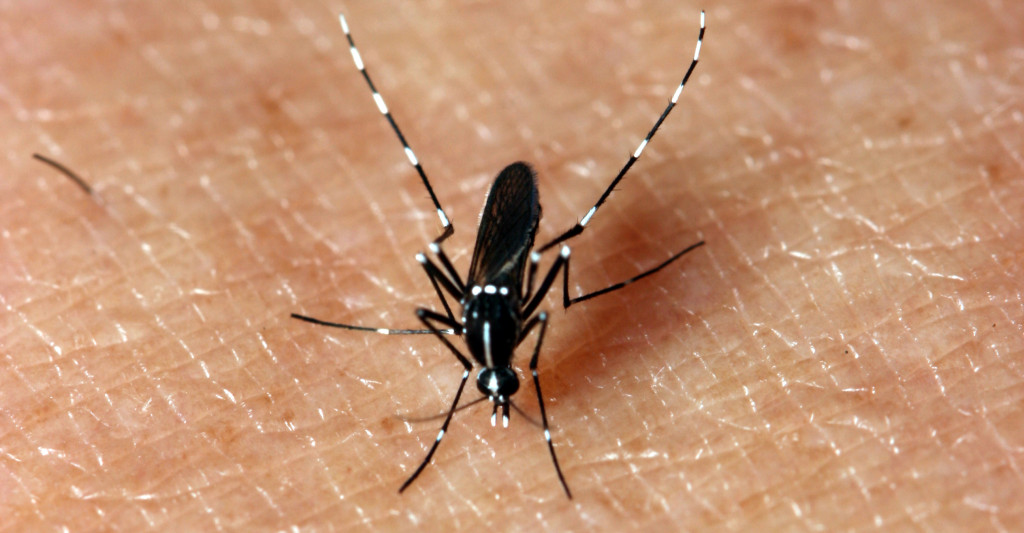
The black and white Asian tiger mosquito is one of the two most common potential vectors of chikungunya in Texas
Over 30 years ago as a graduate student taking a course in medical entomology, I learned about all kinds of diseases spread by insects. By far, most of these were tropical and exotic-sounding. I figured that, if I lived and worked in the U.S., my chances of encountering most of these pathogens was practically nil.
Chikungunya (chik-un-GOON-ya) virus was one of those diseases I memorized way back then, and have since mostly forgotten. The chikungunya disease was first described in 1952 during an outbreak in southern Tanzania (east Africa). The name comes from the Makonde language and means “that which bends up”, referring to the contorted, bent-over appearance due to joint pain suffered by those who contract the disease. Sounds bad doesn’t it?
While not as serious as some mosquito-borne diseases, including malaria or Eastern equine encephalitis, or even the neurological form of West Nile virus, this virus is nothing to sneeze at. While some people have mild cases, it frequently comes with a very bad headache, joint pain, rash and fever. There is no treatment for chikungunya, and there is no vaccine to protect you if you go where the disease is active.
When I learned about chikungunya in college, it was found only in eastern Africa and parts of India and Southeast Asia. That distribution has spread in recent years as outbreaks occurred in parts of western Africa and Europe. In December 2013 the first epidemic on our side of the world was reported when the disease made the jump into the islands of the Caribbean. Since 2014 the disease has been spreading like wildfire, with more than a quarter million cases, and over 20 fatalities in the Caribbean.
Chikungunya has been on the radar of U.S. health officials in recent years because of its vectors–those mosquito species that help it spread. The principal vectors of chikungunya, mosquitoes in the genus Aedes, are very common in the U.S., especially since the introduction of the Asian tiger mosquito, Aedes albopictus, in the 1990s. In Texas and in many parts of the South and East today, the most common summertime biting mosquitoes are the tiger mosquito and its close relative, the yellow fever mosquito, Aedes aegypti. These are the species that inevitably bite me whenever I chance a trip outside without repellent in my backyard here in the Dallas area.
Unlike West Nile virus, birds are not involved in the chikungunya disease cycle. As far as we know, the virus can only be transmitted by the mosquitoes among primates. In Africa, the disease lurks both within humans and non-human primates, such as baboons and monkeys. For the virus to take hold here in the U.S., it would have to be common enough to reach an epidemic tipping point. This would occur when enough people were infected to start a cycle from human to mosquito to human again.
We may not have yet reached that tipping point, but we could get there easily. This week the first locally acquired cases were reported in Florida. These were the first cases reported where the victims had not recently traveled to the Caribbean, or other places where the disease is found. According to the CDC, between 2006 and 2013 we averaged about 28 cases of chikungunya annually from travelers. Since the beginning of this year there have been 243 travel-associated cases in the U.S. And, according to a July 15 release by the Texas Department of State Health Services, five cases have been reported in Texas so far this summer.
So should Texans be worried about chikungunya? If you plan travel to the Caribbean this year, definitely! Make sure to carry repellent and use it liberally during your travels to any Caribbean island. At home there is little risk yet; but this could change. As the number of sick travelers returning from Caribbean cruises and high school missions trips increases, the risk of locally acquired chikungunya will increase. All the more reason for listening when health officials remind us of the four Ds:
- Drain and dump standing water
- Dusk and dawn are the highest risk times for mosquitoes (though the Aedes mosquitoes are active all day)
- Dress in long sleeved shirts and long pants when outdoors
- DEET is an ingredient to look for in your insect repellent (or another effective choice such as lemon oil of eucalyptus, picaridin, p-menthane 3,8-diol or IR3535).